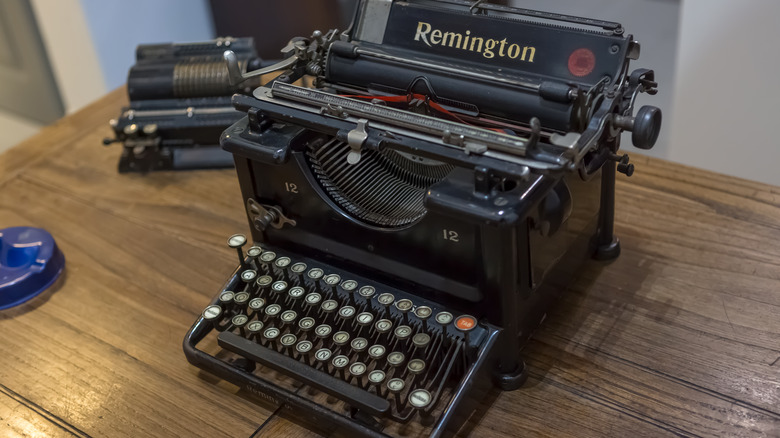When Was The Typewriter Invented?
Modern keyboards owe their evolution to typewriters. These devices put words on sheets of paper, which was a revolution in communication at the time, but they are now considered a kind of ancient technological relic. Like many inventions, the typewriter's look and performance evolved over the years. That said, we can trace the first kind of machinal typing machine to an Italian named Pellegrino Turri, in 1802. According to the World Creativity Science Academy, Turri either invented the machine on his own or modified an invention by Agostino Fantoni. Sadly, we don't know exactly what the machine looked like.
Then, in 1870, Rasmus Malling-Hansen is credited for inventing a new revolutionary device called a writing ball, according to the Malling-Hansen Society. After several improvements, the finished product consisted of a set of keys that sat atop a curved half ball. When struck, the keys would hit a piece of paper placed on a curved plate. The placement of the keys made it easy to type "extremely fast." While this machine was revolutionary, it did not catch on, and it would be more than 50 years before another typing machine would come along.
The first practical typewriters were Remingtons
Many kinds of writing machines were invented in the years following Rasmus Malling-Hansen's writing ball. According to Britannica, some were large, and many operated much slower than handwriting. That changed in 1867 when an American named Christopher Latham Sholes was inspired to try his hand at inventing a typewriter after he read an article in Scientific American that described a typing machine invented in Britain. His second model was patented in 1868, and while it was still basic, he improved it over the next year to the point where it could type faster than writing.
In 1873, Sholes signed a contract with E. Remington and Sons, and one year later, these machines, called Remingtons, were sold to the public. Over the years, they were revised to feature a return carriage, keys that hit an inked ribbon, and the ability to type on spaced lines. Mark Twain reportedly bought one of them and became the first author to submit a typed manuscript.
Sholes invented the QWERTY keyboard
Early typewriters had keys attached to long metal arms, and Sholes' early model had the first half of the alphabet on the bottom row of keys and the second half of the alphabet on the top row, according to CNET. This layout was problematic as the arms would become tangled with each other if hit too rapidly, which would slow down the user. To avoid this problem, Sholes decided to separate common pairings of letters, which would allow the user to type without worrying about the arms becoming jammed. He went through several key layouts before settling on a design similar to the one used on modern keyboards.
Typewriters improved vastly over the years, leading to the invention of the electric typewriter by Thomas Edison in 1872, per Britannica. Electric typewriters became an office staple in 1920 but began to fade in usage when computers became more popular, as The Washington Post points out.


